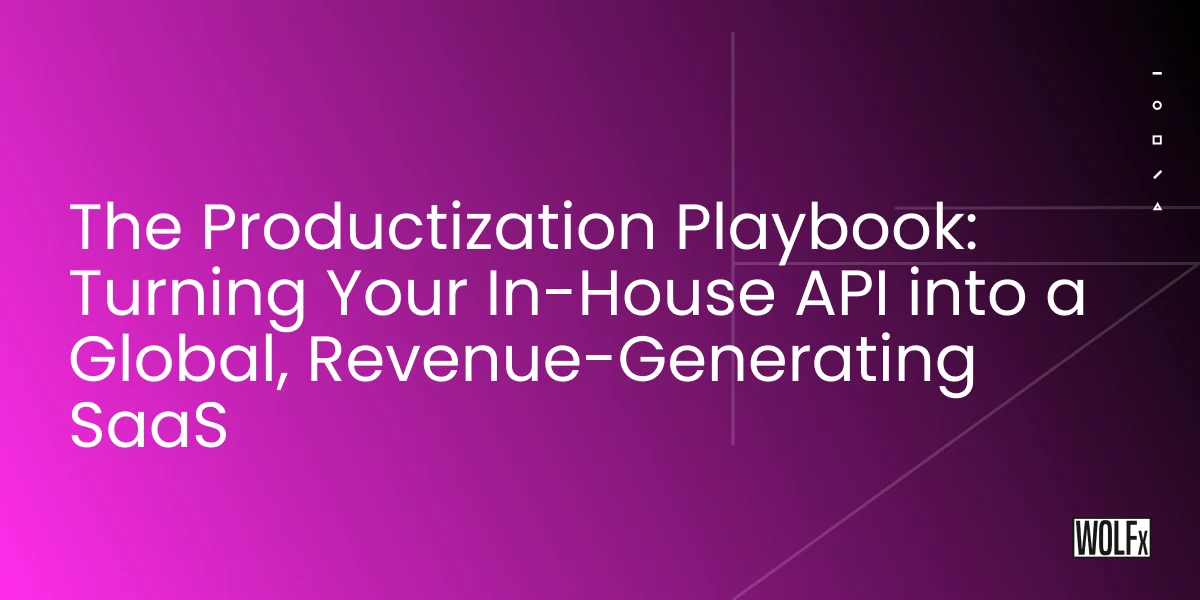In the fast-evolving tech landscape, businesses are realizing the immense potential of turning their in-house APIs into revenue-generating SaaS products. This process, known as API productization, offers a pathway to scale your business globally while generating recurring revenue from APIs that were once internal tools. Whether you're in UI/UX design, AI, blockchain, or eCommerce development, your in-house tools can evolve into powerful SaaS products that attract customers worldwide.
In this playbook, we’ll walk you through the steps to productize your internal API, turning it into a scalable SaaS offering. We’ll also look at various monetization strategies and how API productization aligns with different business models.
What Is API Productization?
API productization refers to transforming an internal API into a marketable, scalable SaaS product. Instead of being an internal tool used only within your organization, a productized API becomes a public-facing service that can be monetized.
This process involves developing an API that solves a specific business need and packaging it as a product for third-party developers or businesses to consume. Once done right, API productization opens the door to recurring revenue and global scalability.
Why Should You Productize Your API?
If your company already has an in-house API, it may contain valuable functionalities that other businesses are willing to pay for. By turning it into a SaaS product, you can:
1. Monetize: Offer your API on a pay-per-use or subscription model, allowing you to generate recurring revenue.
2. Scale: A well-built SaaS API can be used by customers across the globe, from small startups to large enterprises.
3. Leverage existing technology: Instead of building a new product from scratch, you can enhance and productize what you already have.
The SaaS Business Model for API Monetization
In the SaaS business model, your API can be sold on various pricing models. Common approaches include:
1. Freemium SaaS: Offer a basic, free version of your API with limited features, then provide a premium version with more capabilities for paying users.
2. Subscription-based model: Charge users a recurring monthly or annual fee to access your API’s features.
3. Pay-per-use API: Charge customers based on their usage of the API, which can be ideal for services with varying usage patterns.
Steps to Turn Your In-House API into a Global, Revenue-Generating SaaS
Here’s how to productize your API:
1. Identifying the Right Market Need
Before you can turn your internal API into a global SaaS, you need to ensure there’s demand for it. Analyze the market to see if your API product solves real pain points in the industry. Whether it's in cybersecurity, mobile application development, or eCommerce, identifying a gap or need that your API can fill is key.
2. Refine the API for Scalability and Security
The next step is refining your API architecture. As a SaaS product, your API must handle high traffic loads while being secure, reliable, and scalable. Implement features like multi-region availability, data encryption, and rate-limiting to ensure your API is production-ready.
3. Define Your Pricing Strategy
Your API's pricing model is critical for customer acquisition and long-term profitability. You can choose from various pricing options such as freemium, pay-per-use, or subscription-based models. Choose a model that fits your business goals and customer expectations.
4. Build Developer Tools and Documentation
A key component of API productization is creating a seamless experience for developers. Providing comprehensive API documentation, SDKs, and developer tutorials helps customers understand how to integrate your API into their systems.
Develop a developer portal where users can find sample code, integration guides, and community support. This helps boost your developer experience and enhances adoption rates.
5. Launch Your API as a SaaS
Once your API is ready for the market, it’s time for the SaaS product launch. Focus on a go-to-market strategy that includes content marketing, developer marketing, and leveraging platforms like API marketplaces. Highlight your API’s unique value proposition and demonstrate how it can help solve pain points in industries such as blockchain, AI, and eCommerce.
Scaling Your SaaS API Globally
As you transition your API product into a fully operational global SaaS, scaling it will become crucial. You’ll need to build a cloud-based SaaS infrastructure that supports high availability, low latency, and multi-region scaling.
Additionally, ensure you’re prepared for SaaS operational costs, including hosting, bandwidth, and disaster recovery planning. To truly scale globally, invest in redundant systems and utilize a content delivery network (CDN) for faster API performance across regions.
Keywords: cloud-based SaaS, global SaaS scaling, multi-region API, SaaS disaster recovery, API global availability
Monetizing Your API for Long-Term Revenue
The ultimate goal of API productization is to generate recurring revenue. Here's how you can optimize your API SaaS for monetization:
1. Freemium SaaS: This model gives potential customers a taste of your API with basic features, encouraging them to upgrade to paid plans.
2. Subscription-based API pricing: This model offers steady, predictable income while scaling.
3. Pay-per-use API: Useful for customers who need flexible pricing based on usage.
Whichever model you choose, make sure your API SaaS pricing aligns with customer expectations and reflects the true value your API delivers.
Marketing and Growing Your SaaS API
Marketing your newly productized API is essential for driving customer acquisition and scaling. Here are a few marketing strategies:
SEO for SaaS: Optimize your API product pages and documentation for search engines.
Content Marketing: Create blog posts, case studies, and tutorials to educate developers and potential customers.
Community Engagement: Foster a developer community where users can share ideas, integrations, and issues. Offering support and building relationships will increase adoption rates.
Turning Your API Into a SaaS
API productization offers tech companies a significant opportunity to turn in-house tools into revenue-generating SaaS products. By following the steps in this playbook, you can refine your API for scalability, create a developer-friendly experience, choose the right pricing model, and implement a successful launch strategy.
The future of SaaS lies in leveraging existing internal tools and transforming them into products that serve global markets. Now is the time to take your API productization efforts seriously and unlock new revenue streams.
Keywords: API productization, SaaS product growth, API monetization, SaaS business model, API to SaaS transformation, API revenue generation

